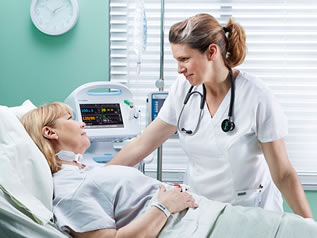Pressure ulcers: what you need to know

Pressure ulcers, also known as bedsores, are an injury that breaks down the skin and underlying tissue. They are caused when an area of skin is placed under constant pressure. It is an injury commonly found in those who struggle to move around, such as those who are bed bound or in wheelchairs, with most occurring when a person is in hospital. They affect approximately 4 in every 100 people admitted to hospital. The treatment of pressure ulcers has traditionally been left to nurses, however the growing nursing shortage has led to many instances of severe life threatening pressure ulcers which could have been avoided.
An investigation by Scotland on Sunday found that at least 21 people died as a direct result of the painful sores between 2011 and 2015, with staff shortages being penned as a key contributing factor. Nurses continue to struggle to cope with rising numbers of elderly patients on the wards meaning many vulnerable patients are being left without adequate care. The number of nurses continues to fall and with nurse’s wages remaining low there appears to be little in the form of a financial incentive to redress this. Florence Nightingale famously said in 1859, “If he has a bedsore, it's generally not the fault of the disease, but of the nursing” and with little being done to encourage more people to join the nursing profession, the crisis is expected to worsen.
In recent years much has been done in an attempt to raise awareness around the pressure ulcer crisis. The National Pressure Ulcer Advisory Panel (NPUAP), an independent not-for-profit professional organisation dedicated to the prevention and management of pressure ulcers, has done much to raise awareness for the existence and threat of pressure ulcers, “The National Pressure Ulcer Advisory Panel (NPUAP) is proud to announce that World Wide Pressure Injury Prevention Day is to be celebrated on November 17, 2016. The objective of STOP 2016 World Wide Pressure Injury Prevention Day is to increase national awareness for pressure injury prevention and to educate the public on this topic.”
On November 17th, charities and companies around the world raised awareness on social media and voiced their support for the cause. On that day, the first-ever consensus document was released which highlighted the important role of dressings in pressure ulcer prevention. There is a need for more awareness and education around pressure ulcers and the importance of effective dressings to ensure that patients are aware of the preventative methods they can take to lessen their chance of developing pressure ulcers. With nurses struggling to keep up with the rapid increase in demand, the time for patient empowerment is now. Here are a few ways in which you can take control in lowering your chances of developing a pressure ulcer
- Change your position as much as possible – don’t sit around for too long in one position. Move around, turn on a different side, stretch your legs and walk around.
- Make sure you eat and drink the right things - It is important that you are eating a balanced diet and drinking plenty of fluids to help prevent pressure ulcers.
- Check your skin regularly – check your skin as often as possible. If you are in a high risk group or you have limited mobility, keep an eye on your skin for warning signs. For more information on the different stages of pressure ulcers so you know what signs and symptoms to look for, please visit the NHS choices page on Pressure Ulcer symptoms.
- Make sure it fits – for those of you who do use wheelchairs, make sure you aren’t in a wheelchair that is too tight or restricting. The more fitted your wheelchair is to you the more likely you are to develop pressure ulcers. Get it resized if it starts getting a bit snug.
If you have any questions about pressure ulcers, or you think you may be developing one, join in the conversation on our talkscarsandwoundcare forum.
Sources of evidence available on request.
Information contained in this Articles page which doesn’t state it has been written by talkhealth, has been written by a third party, who has not paid to be on the talkhealth platform, and has been published with their permission. talkhealth cannot vouch for or verify any claims made by the author, and we do not endorse any specific products, brands, or treatments mentioned. The content in our Articles pages should not be considered a substitute for medical advice. You should always seek medical advice before changing your treatment routine.
Last revised: 12 December 2016
Next review: 12 December 2019


